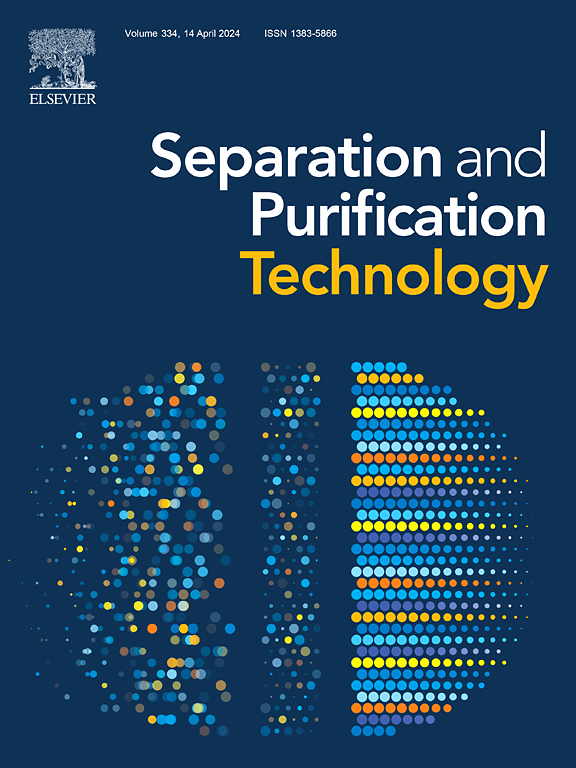Separation of Cd and Ni from Ni-Cd batteries using thiosulfate as leaching, precipitating and separating agent via photochemical method
IF 8.1
1区 工程技术
Q1 ENGINEERING, CHEMICAL
引用次数: 0
Abstract
In recent years, recycling spent batteries has become a critical issue. In this study, the thiosulfate system which is used as leaching, precipitating, and separating agent was adopted, while the process combined with thiosulfate leaching, precipitation recovery, and UV photolysis separation steps was carried out to recycle spent nickel-cadmium (Ni-Cd) batteries. In the leaching process, Cu2+ provided by copper sulfate (CuSO4) synergistically catalyzes the efficient leaching of Ni and Cd through oxidation and the formation of soluble complexes with S2O32−. The experimental results and statistical analysis revealed that the leaching rate of Cd is only 34.79 % without adding CuSO4 as catalytic oxidant, while Ni cannot be leached. At 0.01 mol/L CuSO4 concentration, the leaching efficiency of Cd at 70 °C and 8 h was 90.47 %. Meanwhile, Ni reached a leaching efficiency of 42.46 %, and the initial separation coefficient between Cd and Ni was 0.47. Rhodamine B (RhB) was degraded by leaching residue, and the degradation effect of 30 mg leaching residue on 15 mg/L RhB reached 95.87 %. Based on the photochemical differentiation of metal thiosulfate complexes, the photolysis process for Cd selectively separated from Cd and Ni containing leach solutions under UV photochemistry was explored. A UV light source with a wavelength of 254 nm was chosen, and the rate constant for the photolysis of the Cd thiosulfate complex at a Na2S2O3 concentration of 0.3 mol/L was 0.00321 min−1, while the Ni thiosulfate complex remained largely failed to photolysis. Finally, Cd in the solution was converted into CdS precipitate with a precipitation rate of 88.39 %. The separation coefficient between Cd and Ni was 0.12 × 10−3, achieving the selective separation of Cd and Ni.

以硫代硫酸盐为浸出沉淀分离剂光化学方法从镍镉电池中分离Cd和Ni
近年来,回收废旧电池已成为一个关键问题。本研究采用硫代硫酸盐体系作为浸出沉淀分离剂,采用硫代硫酸盐浸出沉淀回收和紫外光解分离相结合的工艺对废镍镉电池进行回收。在浸出过程中,硫酸铜(CuSO4)提供的Cu2+通过氧化和与S2O32−形成可溶性配合物协同催化Ni和Cd的高效浸出。实验结果和统计分析表明,在不添加CuSO4作为催化氧化剂的情况下,Cd的浸出率仅为34.79%,而Ni则不能被浸出。在0.01 mol/L CuSO4浓度下,Cd在70 ℃、8 h下的浸出率为90.47 %。同时,Ni的浸出效率为42.46 %,Cd与Ni的初始分离系数为0.47。浸出渣对罗丹明B (Rhodamine B, RhB)进行了降解,30 mg浸出渣对15 mg/L RhB的降解效果达到95.87 %。基于金属硫代硫酸盐配合物的光化学分化,探讨了在紫外光化学条件下,镉与含镉、含镍浸出液选择性分离的光解过程。选择波长为254 nm的紫外光源,在Na2S2O3浓度为0.3 mol/L的条件下,硫代硫酸镉配合物的光解速率常数为0.00321 min−1,而硫代硫酸镍配合物基本不能光解。最后,溶液中的Cd转化为Cd沉淀,析出率为88.39 %。Cd与Ni的分离系数为0.12 × 10−3,实现了Cd与Ni的选择性分离。
本文章由计算机程序翻译,如有差异,请以英文原文为准。
求助全文
约1分钟内获得全文
求助全文
来源期刊

Separation and Purification Technology
工程技术-工程:化工
CiteScore
14.00
自引率
12.80%
发文量
2347
审稿时长
43 days
期刊介绍:
Separation and Purification Technology is a premier journal committed to sharing innovative methods for separation and purification in chemical and environmental engineering, encompassing both homogeneous solutions and heterogeneous mixtures. Our scope includes the separation and/or purification of liquids, vapors, and gases, as well as carbon capture and separation techniques. However, it's important to note that methods solely intended for analytical purposes are not within the scope of the journal. Additionally, disciplines such as soil science, polymer science, and metallurgy fall outside the purview of Separation and Purification Technology. Join us in advancing the field of separation and purification methods for sustainable solutions in chemical and environmental engineering.
 求助内容:
求助内容: 应助结果提醒方式:
应助结果提醒方式:


